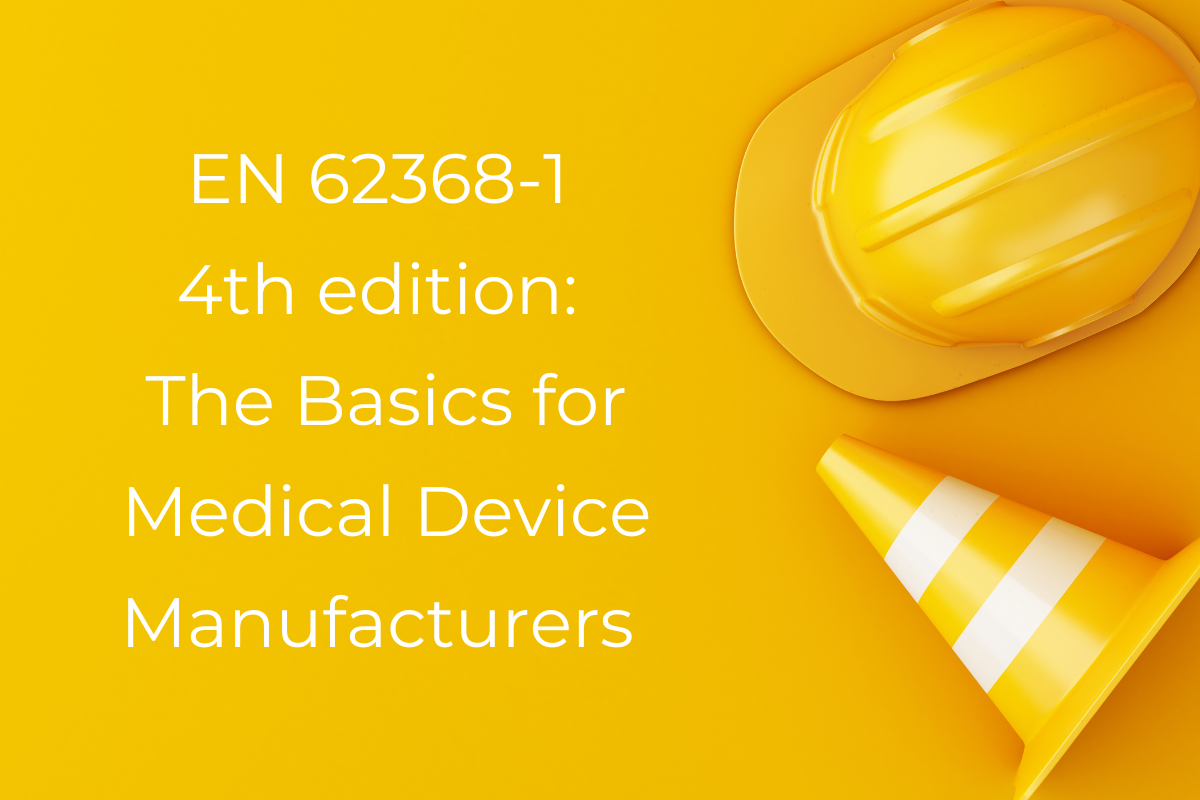What Medical Device Manufacturers Should Know about IEC 62368-1
In May 2023, the 4th edition of EN 62368-1 was published. This standard provides general requirements for both audiovisual (AV) and information technology equipment (ITE) for devices that play a role in many different industries, including health care. Depending on where you want to market your device, or whether you’re putting out something new, you may need to follow the guidelines provided in EN/IEC 62368-1, which now supersedes both IEC 60950-1 for information technology equipment and IEC 60065 for AV equipment. We’ll cover the basics of the standard and what’s on the horizon for the 4th edition.
What is EN 62368-1?
EN 62368-1, also known as IEC 62368-1, is a safety standard for electrical and electronic products. Different energy types are identified within the standard – electricity, batteries, and chemicals, to name a few.
For each of these energy types, the standard outlines specific safeguards and how they can be designed. As an example, a fuse or circuit breaker could be used to protect against electrical shock.
The standard also includes performance requirements for standards. Regulations outlined in the standard are meant to identify and mitigate potential hazards like fire, radiation, and electrical shock. Reducing these harms also means that pain, injury, and property damage (from fire) will also decrease. The full document offers detailed requirements that help manufacturers design safe equipment.
A wide array of medical devices that would qualify as information technology equipment and consumer electronics are applicable under this standard.
What standards does EN 62368-1 replace?
This updated standard replaces EN 60950-1 (Information Technology Equipment, Safety) and EN 60065 (Audio, Video, and Similar Electronic Apparatus – Safety) requirements. The idea is to cover both information technology equipment (ITE) and audio/video (AV) products under a single standard, instead of having them separated. The two standards were formally replaced in December 2020, but it’s important to note that this replacement did not simply combine the two standards. The framework is also distinct.
EN 62368-1 is a Hazard-Based Standard
Instead of being dependent on the product, like many standards are, IEC 62368 is built on the principle of hazard-based standard engineering (HBSE). This is why safety requirements are divided by the type of energy within the equipment and how to safeguard against relevant hazards. One of the ideas behind this was to “future-proof” the standard and not have to change it with new products or technologies.
Types of Safeguards Under IEC 62368-1
The scheme or device that is used to protect against a specific hazard from an energy source is called a “safeguard” under EN 62368-1.
Safeguards are divided by type (equipment, installation, personal, instructional) and level (basic, supplementary, enforced).
- Equipment safeguards are parts of the physical equipment.
- Installation safeguards are put in place after installation.
- Personal safeguards can be worn on the body.
- Instructional safeguards involve instructed behavior.
Basic safeguards outline what should be working under normal operating conditions. Supplementary safeguards, such as fire enclosures, are in place in case the basic safeguards don’t work. Reinforced safeguards are designed for single-fault conditions, where one thing is going wrong on the device. This could include electrically insulated gloves or reinforced insulation.
Types of People Under EN 62368-1
Hazards are also dependent on the people operating or using the device. They are divided as either skilled, instructed, or ordinary people. Skilled people should know enough of the technical specifics of a device to know which energy sources could be hazardous and cause potential injury. Instructed people are trained by skilled people and ordinary people are those who don’t fall into any other category.
If the device is accessed by all levels of people, it’s important to understand that the standards will be different than if it is only accessed by skilled people.
Which manufacturers will have to know about this standard?
Currently, products that are certified under previous standards in North America can still produce and market their products. This is true as long as they don’t make any major changes that would call for re-testing.
For North American manufacturers looking to export their products, certification may be required under EN 62368-1. However, as of May 2023, the 2nd and 3rd editions of EN 62368-1 have been recognized in many other countries. It’s predicted that the EU will adopt the 4th edition by late 2023 or early 2024. Canada and the US should get on board around the second half of 2024. Keep an eye on developing news on these standards to understand what you might need before going to market with a new device.
It’s not likely to see a harmonized standard listed before the end of 2024. Right now, EN 62368-1:2014 is the only harmonized standard.
IEC 62368-1 and PSUs
Are looking for a power supply unit for your medical device that is compliant with EN 62368-1? Please reach out to us. All of our power supplies comply with the standard; however, only one has been certified for it so far. This came about due to a customer request for a device they were marketing in Japan. If you require certification for another power supply we offer, talk to us today.
RAM Technologies’ power supplies are 60601-1 3.2 certified and meet 60601-1-2 EMC standards. When you’re designing your medical device and need help with a PSU, contact us for details.
More Resources:
Downloadable Guide to IEC 60601-1
EMC Compliance Testing for Medical Devices
Current Trends in the Medical Device Industry
How to Choose the Right Power Supply For Your Medical Device



